E3S REU Participants and Projects: 2019
Undergraduate Researcher: Raquel Zubia
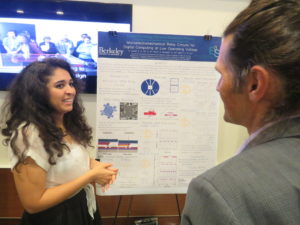
Major: Electrical Engineering
Home Institution: University of Texas, El Paso
Research Project: Microelectromechanical Relay Circuits for Digital Computing at Low Operating Voltage
Faculty Advisor: Dr. Tsu Jae King-Liu
Graduate Student Mentor: Alice Ye
Project Abstract:The proliferation of Internet-of-Things devices has increased demand for energy-efficient electronics. Micro-electro-mechanical (MEM) relays have shown great promise as an energy-efficient alternative to today’s metal-oxide-semiconductor field effect transistors (MOSFET). In this work, a new current-source waveform generator was used to reduce the voltage mean squared error (VMSE) by 2.2x compared to a voltage-source waveform generator. This enables testing of low-voltage MEM circuits. Pass-gate logic MEM relay circuits were also successfully demonstrated with the low-noise setup at room temperature.
Undergraduate Researcher: Luis Hurtado
Major: Electrical Engineering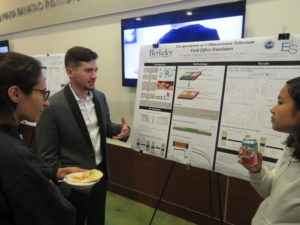
Home Institution: University of Central Florida
Research Project: Encapsulation of Tellurium Field Effect Transistors
Faculty Advisor: Dr. Ali Javey
Graduate Student Mentor: Chunsong Zhao
Project Abstract: The continuous growth and integration of smart technology drives the expansion of Internet of things (IoT). Thus, there’s a push towards high performing flexible electronic devices and their success would drastically expand IoT with sophisticated applications such as wearable products. To achieve this, integration of these devices on polymer substrates is needed to guarantee its flexibility and performance. Currently, there is a lack of low temperature growth (Low-T) high performing p-type semiconducting material for these applications. Our tellurium (Te) thin films are p-type semiconductors that exhibit excellent electrical properties with Low-T growth allowing its integration on flexible substrates. However, Te faces issues with thermal instability at higher temperatures that reduces its performance. Herein, we report the encapsulation of Te based field effect transistors (FETs) utilizing silicon dioxide (SiO2) to improve the thermal instability. Without this encapsulation the Te channel evaporates after devices are annealed at 250℃ with nitrogen (N 2 ) flow and evaporates at 300℃ in air. After encapsulation the Te channel remains intact for the aforementioned temperatures, however, performance of the devices still degrades. Overall, our encapsulation method aims at mitigating the instability of Te thin films at higher temperatures allowing for its use in future electronics.
Undergraduate Researcher: Bao Lam
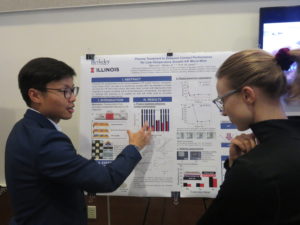
Major: Materials Science
Home Institution: University of Illinois at Urbana-Champaign
Research Project: Plasma Treatment to Enhance Contact Performance for Low-Temperature Growth InP Microwire
Faculty Advisor: Dr. Ali Javey
Graduate Student Mentor: Wenbo Ji
Project Abstract: InP is an important transistor channel material due to its high electron mobility and suitable bandgap. However, the costly and high-temperature growth methods limit its extensive application. A novel growth method for InP, low temperature templated- liquid-phase (LT-TLP), is developed recently, which shows its potential as a future growth technique whereas the high contact resistance on TLP grown InP microwires still needs to be improved. Thus, our goal is to explore an as-deposited low resistance contact structure for InP microwire device. Non-alloy metal contact with plasma pre-clean treatment is a good candidate due to its low fabrication temperature. Our approach to optimize this structure is to explore on bulk InP wafer prior to complete fabrication on microwire device.
Undergraduate Researcher: Micah Roschelle
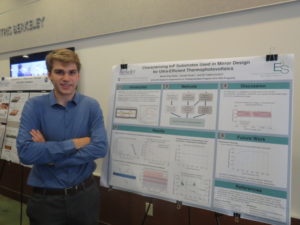
Major: Electrical Engineering
Home Institution: Columbia University
Research Project: Characterizing InP Substrates used in Mirror Growth for Ultra-efficient Thermophotovoltaics
Faculty Advisor: Dr. Eli Yablanovitch
Graduate Student Mentor: Zunaid Omair
Project Abstract: Recently, it has been demonstrated that the efficiency of thermophotovoltaic (TPV) systems can be significantly enhanced by utilizing the band-edge and a highly reflective mirror as a spectral filter. In this design, TPV efficiency can be further improved by increasing mirror reflectivity, motivating the implementation of better mirrors in TPV systems. To experiment with new mirror design and fabrication techniques, semi-insulating InP is used as a substrate for mirror growth. However, the measured reflectivity of mirrors grown in this way has fallen short of theoretical predictions. In order to understand the effect of the substrate on mirror reflectivity, we measured and calculated optical and electrical properties of the substrates. In comparing these values with those predicted by theory, we conclude that this discrepancy in measured reflectivity is not from free carrier absorption in the substrate as hypothesized, but is due to an instrumentation error.
Undergraduate Researcher: Ashton Hattori
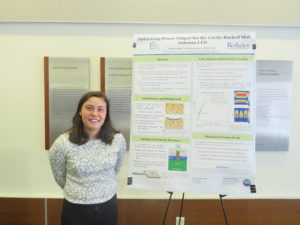
Major: Electrical Engineering
Home Institution: Georgia Tech
Research Project: Optimizing Power Output for the Cavity-Backed Slot Antenna-LED
Faculty Advisor: Dr. Ming Wu
Graduate Student Mentor: Nicolas Andrade
Project Abstract: On-chip integration of optical sources reduces on-chip energy consumption, which is essential for next generation data communication. An optical system consisting of an LED coupled to a cavity-backed slot antenna that allows for an enhancement factor of up to 300 has been proposed. This optical system would allow for > 100 GHz modulation rates, however, the current model limits data rate to 20 Gbps due constraints on output power. Here, a way to optimize the antenna-LED geometry to optimize power output is proposed. Optimization can be achieved by simulating and testing various geometries of the antenna-LED, ultimately leading to higher output power and allowing for higher modulation rates.